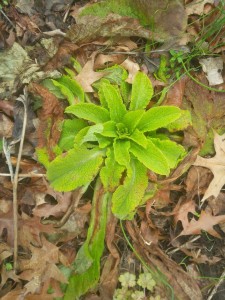The garden looks desolate right now because winter does not have the good sense to pack up its snowy bags and go away. Despite that, the foxgloves thrive. Even when wintery mix threatens in April, their lettuce-like basal rosettes spring up stubbornly from the earth, challenging the elements to a seasonal smack-down. Old man winter doesn’t know it, but my money is on the foxgloves.
I confess that I have steadfastly underestimated foxgloves, or Digitalis species, throughout my gardening career. There are at least 19 of them, in addition to countless cultivated varieties and hybrids. All are native to southern Europe or western Asia, but they arrived on North American shores early. Digitalis purpurea, or common foxglove, was first described by Virginian John Custis in 1737. Other species were not far behind and since then, the plants have been stalwart survivors. My garden is a case in point, with foxgloves that succeed in part shade, part sun and even full sun, blooming beautifully through the growing season. They look coarse and rather nondescript when out of flower, but light up the landscape when the blooms break out.
Most gardeners and flower lovers are familiar with foxglove. The stalks are tall and relatively thick, with scores of elongated bell-shaped flowers on each one. Opening sequentially from the bottom of the stalk to the top, flower colors range from shades of white, cream and yellow, through the pink and peach range, to rose, purple and nearly black. The lips or throats are often speckled in maroon, purple or brown.
Some foxgloves are perennial plants, but the most popular types are biennial, meaning that the plants establish a basal rosette of leaves the first year, then flower, set seed and die in the second year. In practical terms, if you plant foxglove seeds or young plants two years running, the resulting garden display might as well be perennial. A single plant can produce tens of thousands of minute seeds, many of which germinate readily in the average garden. Once foxgloves get started, they do not know when to stop. Fortunately, young seedlings are easy to dig up and move around, so overpopulation is a blessing rather than a curse.
My garden will be full of foxgloves if the wintery weather ever stops. The tallest, which bloom in early summer, are hybrids of Digitalis purpurea. Despite the Latin name, which comes from the word for “purple”, the flowers are white or pastel tinted. Popular purpurea hybrids include white-fingered ‘Snow Thimble’, rosy lavender ‘Dalmatian Purple’, and peachy ‘Apricot Beauty’. Most purpureas grow between 24 and 36 inches tall, depending on soil, light and moisture conditions.
‘Pam’s Choice’, discovered a couple of decades ago, is another beautiful purpurea cultivar that sports white flowers accented by dramatic maroon throats. I remember reading somewhere that the progenitor of Pam’s Choice was a chance seedling that an English gardener found growing on her compost pile. The story makes a nice metaphor about beauty sprouting amid detritus. True or not, ‘Pam’s Choice’ is stunning in the middle or back of a flower border.
Later in the summer, in another garden bed, the yellow bells of Digitalis grandiflora, sometimes known by the mysterious name, Digitalis ambigua, will bloom near several blue-flowered hydrangea, providing an appealing contrast. This foxglove is a short-lived perennial and a particularly rampant self-seeder. For years I have found its offspring everywhere in my back garden.
Depending on your garden’s color scheme, you may also like Digitalis x mertonensis or strawberry foxglove, a short-lived perennial hybrid that bears large rosy flowers. Another good choice is Digitalis ferruginea or rusty foxglove, with golden-amber “gloves” marked in brown. Like many other foxgloves, it also blooms in late spring to early summer.
The word “digitalis” comes for the Latin word for finger, probably a reference to the thimble-shaped blossoms. The ancient Anglo-Saxons reportedly called the plant “foxes glofa”, and the contemporary common name is derived from that term. According to one legend, elves or fairies gave digitalis blossoms to foxes to wear like mittens, muffling their footfalls while they were on their predacious rounds. You may or may not have mitten-clad foxes traipsing around your garden, but if you have deer, they will avoid foxgloves.
The plants have been used by humans for centuries. Consumed indiscriminately, all digitalis parts are poisonous. However, when the seeds and/or leaves are processed correctly, and the resulting substance prescribed appropriately, the result is an effective treatment for heart-related problems including edema or swelling due to fluid accumulation. William Withering, an English physician, experimented with digitalis in the late eighteenth century and found that it was effective for patients suffering from the hard-to-treat type of edema known then as “dropsy”. Physicians still prescribe drugs derived from digitalis plants.
Grow foxgloves in well-drained soil that has been enriched with compost and water regularly while new plants establish themselves. Though they are often recommended for shade gardens, foxgloves really prefer part or light shade for best flowering. Removing the spent flower stalks will make the plants more attractive, but will also prevent the self-seeding that many of us lazy gardeners find desirable. The choice is up to you, but if you love beautiful, no-fuss flowers, choose foxgloves. You can find them at most nurseries and garden centers starting in the spring, but you can also order from Bluestone Perennials, 7211 Middle Ridge Rd. Madison, OH 44057; (800) 852-5243; www.bluestoneperennials.com. Free print catalog.

